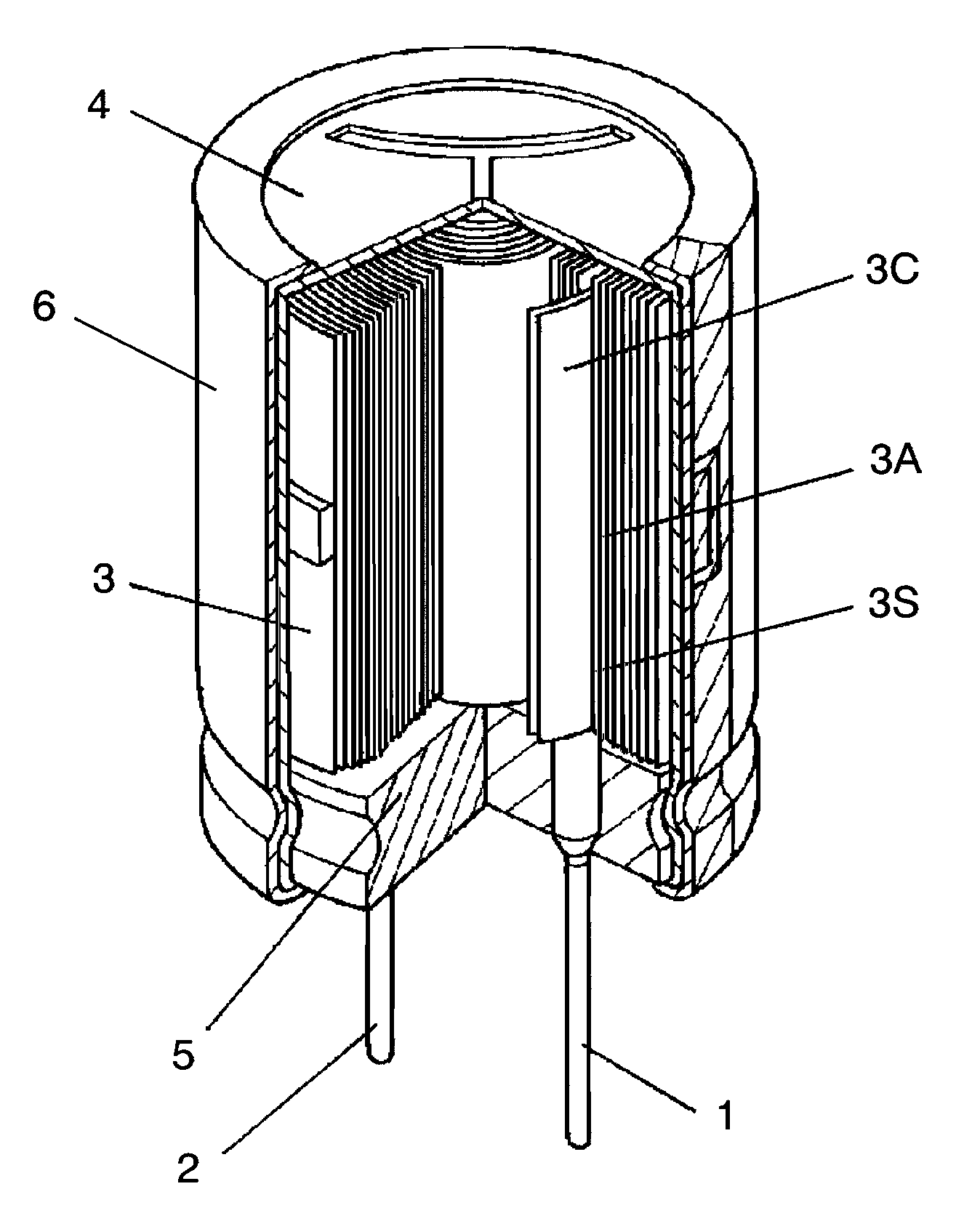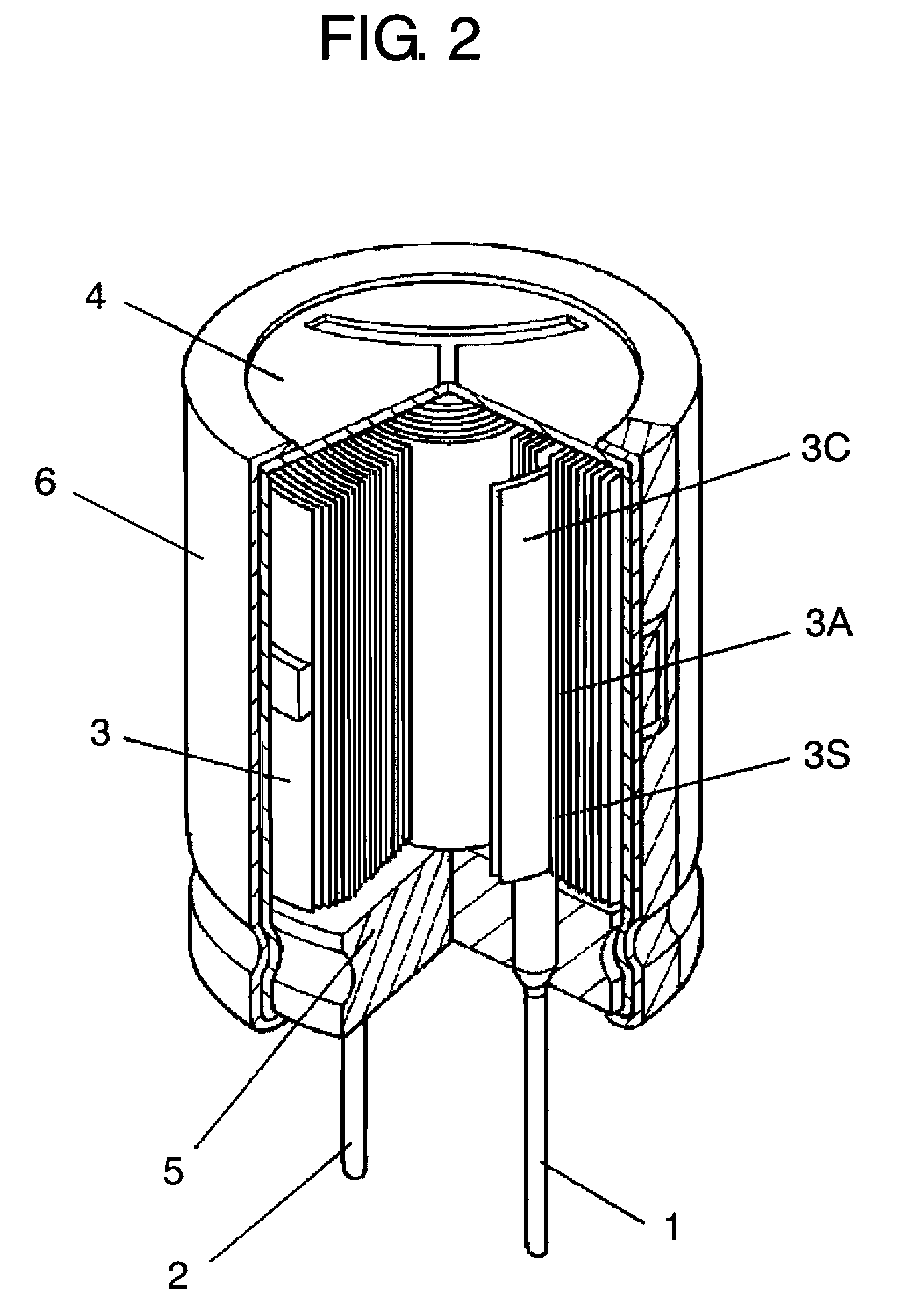Electrolytic capacitor
a technology of electrolytic capacitors and capacitors, applied in capacitor electrodes, capacitors, electrical appliances, etc., can solve the problems of aluminum electrolytic capacitor leakage, deterioration of sealing parts, and rise in thesoldering temperature of assembling electronic devices, so as to prevent electrolyte leakage, high capacitance, and high reliability
- Summary
- Abstract
- Description
- Claims
- Application Information
AI Technical Summary
Benefits of technology
Problems solved by technology
Method used
Image
Examples
example 1
Practical Example 1
[0023]First, a description is made for how an electrolytic capacitor of sample 1 is produced. After the surface of aluminum foil is roughened by etching, a dielectric oxide film (formation voltage: 15V) is formed by anodization to produce positive electrode 3A. Meanwhile, aluminum foil containing 0.3% of copper in bulk is etched to produce negative electrode 3C. Next, positive electrode 3A and negative electrode 3C are rolled up with separator 3S (a mix-made paper of Manila paper and craft paper, thickness: 50 μm, weight: 40 g / m2) disposed between them to produce capacitor element 3.
[0024]Next, capacitor element 3 is impregnated with an electrolyte solution containing complex salt (0.005 wt %) of an azole ring compound (1-methyl imidazole) with copper ions. Here, the electrolyte solution contains 25 wt % of tetramethylimidazolinium phthalate, 3 wt % of p-nitrobenzoic acid, 1 wt % of monobutyl phosphoester, and the rest of γ-butyrolactone.
[0025]Then, after capacito...
example 2
Practical Example 2
[0031]Samples 7 through 12 in this practical example are produced in the same way as in practical example 1 except that the azole ring compound is benzotriazole, and the content of complex salt of the azole ring compound with copper ions in the electrolyte solution is changed. In samples 13 through 18, the azole ring compound is imidazole; in samples 19 through 24, benzimidazole. After reliability tests are performed for samples 7 through 24 in the same way as in practical example 1, each sample is examined for leakage and a short circuit caused by copper precipitation. The specifications and evaluation results of each sample are shown in tables 2 through 4.
[0032]
TABLE 2Blending quantity ofLeaks incomplexhigh-temperaturesalt of benzotriazole withandShort circuitcopper ions (wt %)high-humidity testoccurrencesSample 70.00512Sample 80.0100Sample 90.100Sample 101.000Sample 112.000Sample 122.500
[0033]
TABLE 3Blending quantityLeaks inof complex salt ofhigh-temperatureimi...
example 3
Practical Example 3
[0037]For samples 25 through 28, 1-methyl imidazole which is an azole ring compound is added when preparing the electrolyte solutions and the content thereof is changed. Capacitor samples are produced in the same way as in practical example 1 except that the capacitor elements are impregnated with the electrolyte solutions respectively and each of the electrolyte solutions is reacted with copper present on the surface of negative electrode 3C by heating in aging process. In the same way, for samples 29 through 32, benzotriazole, which is an azole ring compound, is blended when preparing an electrolyte solution; for samples 33 through 36, imidazole; and for samples 37 through 40, benzimidazole. Here, the electrolyte solution contains 25 wt % of tetramethyl ammonium phthalate, 3 wt % of p-nitrobenzoic acid, 1 wt % of monobutyl phosphoester, and the rest of γ-butyrolactone. After reliability tests are performed for samples 25 through 40 in the same way as in practica...
PUM
| Property | Measurement | Unit |
|---|---|---|
| wt % | aaaaa | aaaaa |
| wt % | aaaaa | aaaaa |
| formation voltage | aaaaa | aaaaa |
Abstract
Description
Claims
Application Information
 Login to View More
Login to View More - R&D
- Intellectual Property
- Life Sciences
- Materials
- Tech Scout
- Unparalleled Data Quality
- Higher Quality Content
- 60% Fewer Hallucinations
Browse by: Latest US Patents, China's latest patents, Technical Efficacy Thesaurus, Application Domain, Technology Topic, Popular Technical Reports.
© 2025 PatSnap. All rights reserved.Legal|Privacy policy|Modern Slavery Act Transparency Statement|Sitemap|About US| Contact US: help@patsnap.com



